HYUNDAI ELANTRA HYBRID 2021 User Guide
Manufacturer: HYUNDAI, Model Year: 2021, Model line: ELANTRA HYBRID, Model: HYUNDAI ELANTRA HYBRID 2021Pages: 555, PDF Size: 56.08 MB
Page 11 of 555
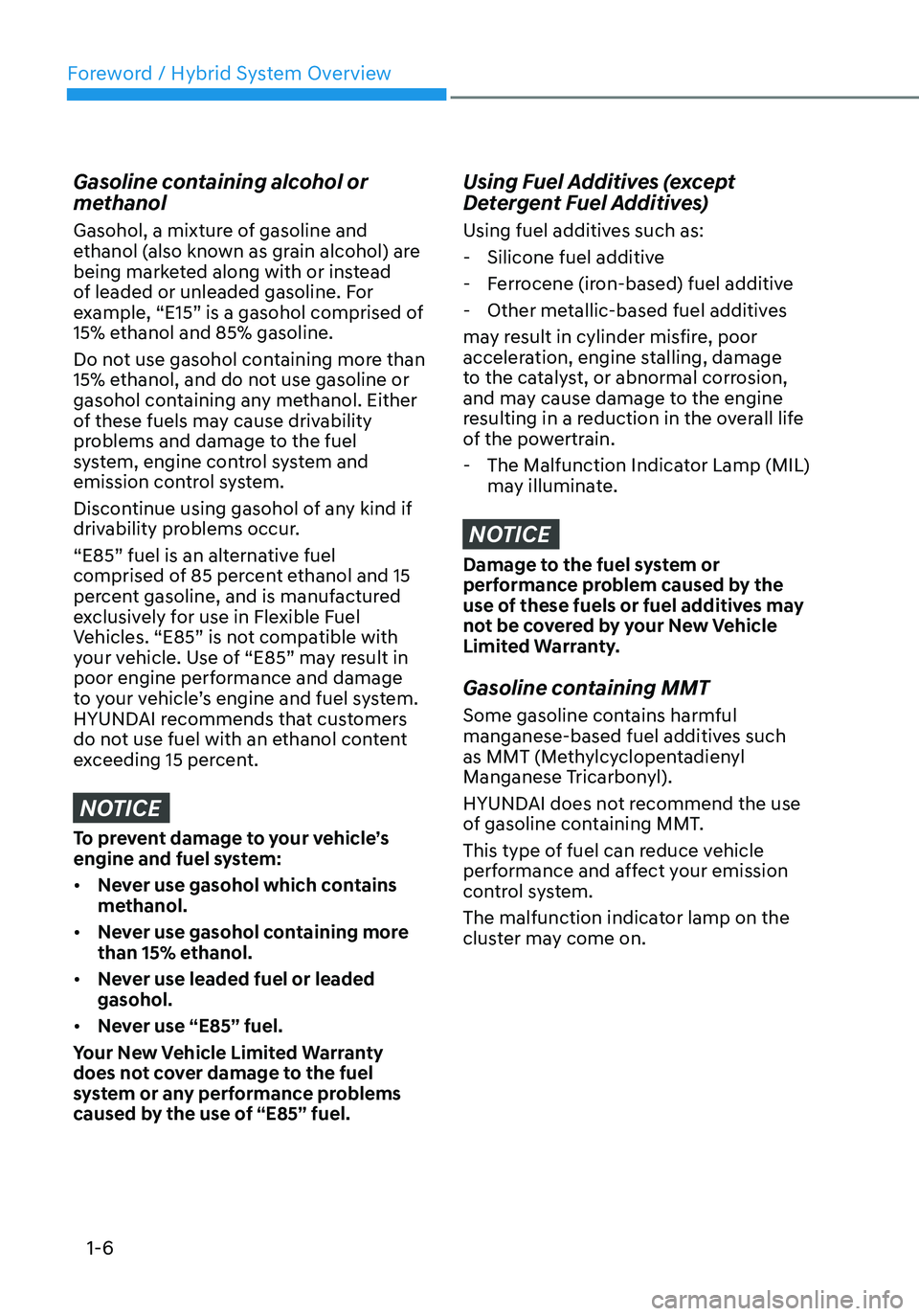
Foreword / Hybrid System Overview
1-6
Gasoline containing alcohol or
methanol
Gasohol, a mixture of gasoline and
ethanol (also known as grain alcohol) are
being marketed along with or instead
of leaded or unleaded gasoline. For
example, “E15” is a gasohol comprised of
15% ethanol and 85% gasoline.
Do not use gasohol containing more than
15% ethanol, and do not use gasoline or
gasohol containing any methanol. Either
of these fuels may cause drivability
problems and damage to the fuel
system, engine control system and
emission control system.
Discontinue using gasohol of any kind if
drivability problems occur.
“E85” fuel is an alternative fuel
comprised of 85 percent ethanol and 15
percent gasoline, and is manufactured
exclusively for use in Flexible Fuel
Vehicles. “E85” is not compatible with
your vehicle. Use of “E85” may result in
poor engine performance and damage
to your vehicle’s engine and fuel system.
HYUNDAI recommends that customers
do not use fuel with an ethanol content
exceeding 15 percent.
NOTICE
To prevent damage to your vehicle’s
engine and fuel system:
• Never use gasohol which contains
methanol.
• Never use gasohol containing more
than 15% ethanol.
• Never use leaded fuel or leaded
gasohol.
• Never use “E85” fuel.
Your New Vehicle Limited Warranty
does not cover damage to the fuel
system or any performance problems
caused by the use of “E85” fuel.
Using Fuel Additives (except
Detergent Fuel Additives)
Using fuel additives such as:
- Silicone fuel additive
-Ferrocene (iron-based) fuel additive
-Other metallic-based fuel additives
may result in cylinder misfire, poor
acceleration, engine stalling, damage
to the catalyst, or abnormal corrosion,
and may cause damage to the engine
resulting in a reduction in the overall life
of the powertrain.
- The Malfunction Indicator Lamp (MIL)
may illuminate.
NOTICE
Damage to the fuel system or
performance problem caused by the
use of these fuels or fuel additives may
not be covered by your New Vehicle
Limited Warranty.
Gasoline containing MMT
Some gasoline contains harmful
manganese-based fuel additives such
as MMT (Methylcyclopentadienyl
Manganese Tricarbonyl).
HYUNDAI does not recommend the use
of gasoline containing MMT.
This type of fuel can reduce vehicle
performance and affect your emission
control system.
The malfunction indicator lamp on the
cluster may come on.
Page 12 of 555
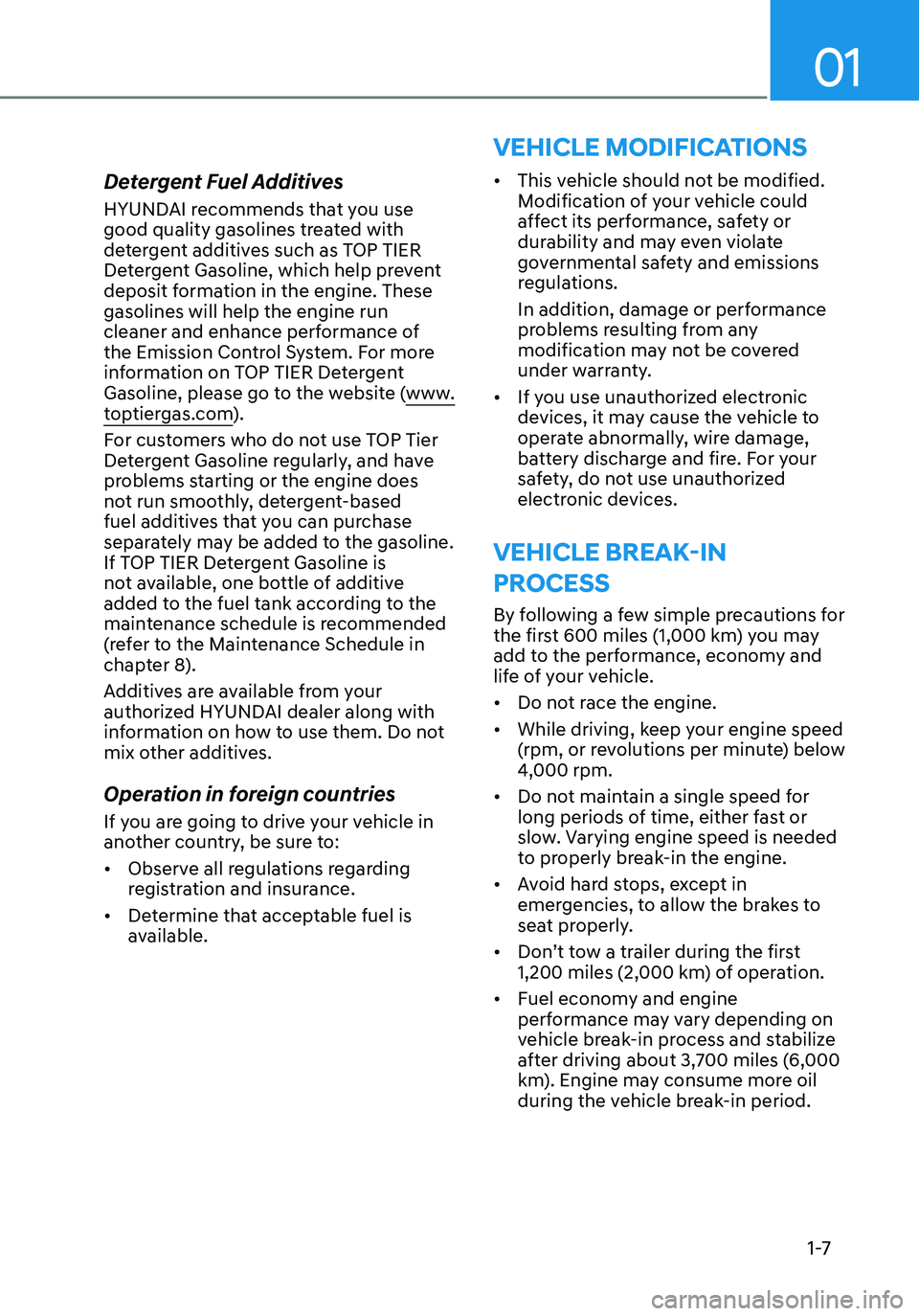
01
1 -7
Detergent Fuel Additives
HYUNDAI recommends that you use
good quality gasolines treated with
detergent additives such as TOP TIER
Detergent Gasoline, which help prevent
deposit formation in the engine. These
gasolines will help the engine run
cleaner and enhance performance of
the Emission Control System. For more
information on TOP TIER Detergent
Gasoline, please go to the website (www.
toptiergas.com ).
For customers who do not use TOP Tier
Detergent Gasoline regularly, and have
problems starting or the engine does
not run smoothly, detergent-based
fuel additives that you can purchase
separately may be added to the gasoline.
If TOP TIER Detergent Gasoline is
not available, one bottle of additive
added to the fuel tank according to the
maintenance schedule is recommended
(refer to the Maintenance Schedule in
chapter 8).
Additives are available from your
authorized HYUNDAI dealer along with
information on how to use them. Do not
mix other additives.
Operation in foreign countries
If you are going to drive your vehicle in
another country, be sure to:
• Observe all regulations regarding
registration and insurance.
• Determine that acceptable fuel is
available. •
This vehicle should not be modified.
Modification of your vehicle could
affect its performance, safety or
durability and may even violate
governmental safety and emissions
regulations.
In addition, damage or performance
problems resulting from any
modification may not be covered
under warranty.
• If you use unauthorized electronic
devices, it may cause the vehicle to
operate abnormally, wire damage,
battery discharge and fire. For your
safety, do not use unauthorized
electronic devices.
VEHICLE BREAK-IN
PROCESS
By following a few simple precautions for
the first 600 miles (1,000 km) you may
add to the performance, economy and
life of your vehicle.
• Do not race the engine.
• While driving, keep your engine speed
(rpm, or revolutions per minute) below
4,000 rpm.
• Do not maintain a single speed for
long periods of time, either fast or
slow. Varying engine speed is needed
to properly break-in the engine.
• Avoid hard stops, except in
emergencies, to allow the brakes to
seat properly.
• Don’t tow a trailer during the first
1,200 miles (2,000 km) of operation.
• Fuel economy and engine
performance may vary depending on
vehicle break-in process and stabilize
after driving about 3,700 miles (6,000
km). Engine may consume more oil
during the vehicle break-in period.
VEHICLE MODIFICATIONS
Page 13 of 555
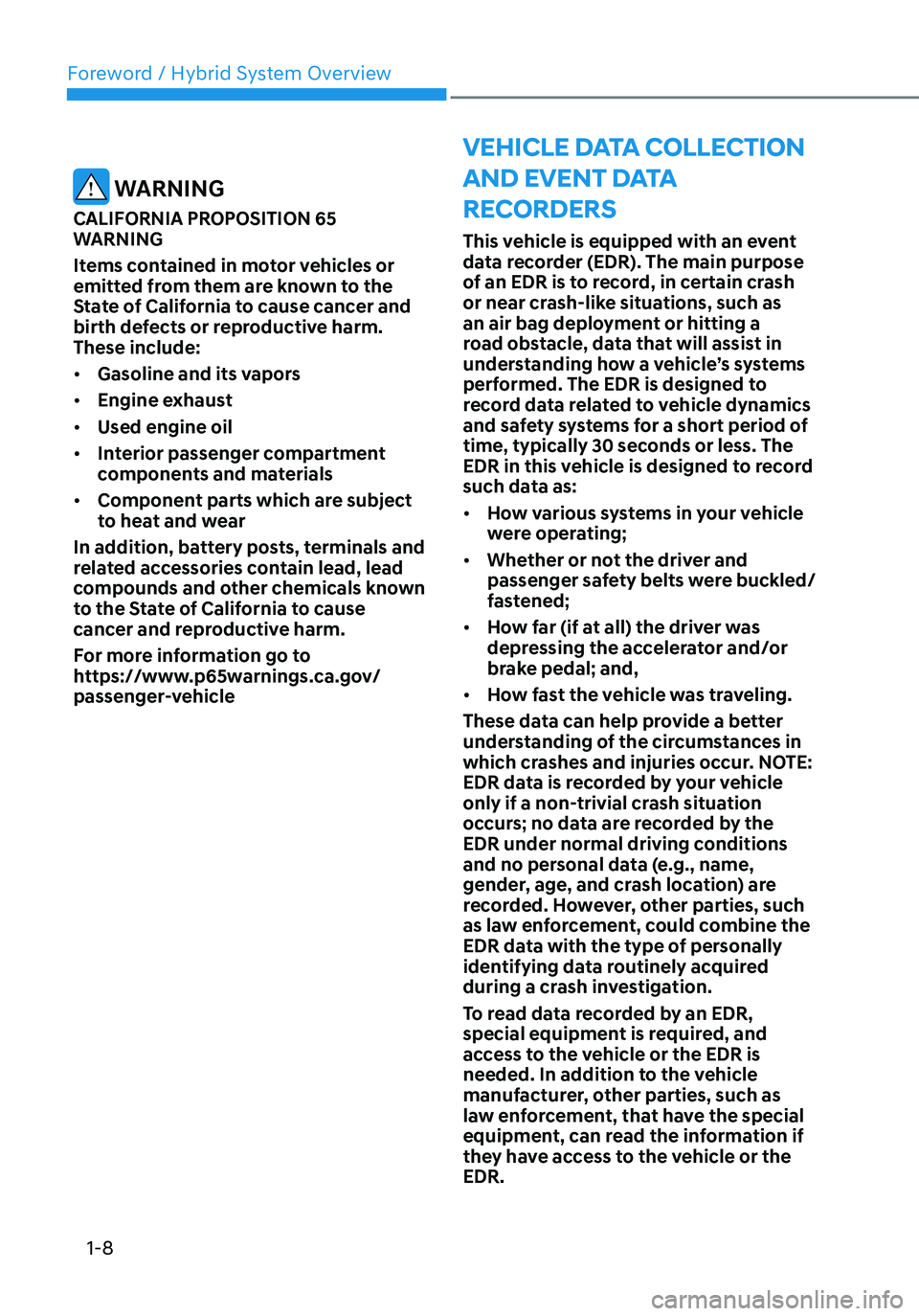
Foreword / Hybrid System Overview
1-8
VEHICLE DATA COLLECTION
AND EVENT DATA
RECORDERS
This vehicle is equipped with an event
data recorder (EDR). The main purpose
of an EDR is to record, in certain crash
or near crash-like situations, such as
an air bag deployment or hitting a
road obstacle, data that will assist in
understanding how a vehicle’s systems
performed. The EDR is designed to
record data related to vehicle dynamics
and safety systems for a short period of
time, typically 30 seconds or less. The
EDR in this vehicle is designed to record
such data as:
• How various systems in your vehicle
were operating;
• Whether or not the driver and
passenger safety belts were buckled/
fastened;
• How far (if at all) the driver was
depressing the accelerator and/or
brake pedal; and,
• How fast the vehicle was traveling.
These data can help provide a better
understanding of the circumstances in
which crashes and injuries occur. NOTE:
EDR data is recorded by your vehicle
only if a non-trivial crash situation
occurs; no data are recorded by the
EDR under normal driving conditions
and no personal data (e.g., name,
gender, age, and crash location) are
recorded. However, other parties, such
as law enforcement, could combine the
EDR data with the type of personally
identifying data routinely acquired
during a crash investigation.
To read data recorded by an EDR,
special equipment is required, and
access to the vehicle or the EDR is
needed. In addition to the vehicle
manufacturer, other parties, such as
law enforcement, that have the special
equipment, can read the information if
they have access to the vehicle or the
EDR.
WARNING
CALIFORNIA PROPOSITION 65
WARNING
Items contained in motor vehicles or
emitted from them are known to the
State of California to cause cancer and
birth defects or reproductive harm.
These include:
• Gasoline and its vapors
• Engine exhaust
• Used engine oil
• Interior passenger compartment
components and materials
• Component parts which are subject
to heat and wear
In addition, battery posts, terminals and
related accessories contain lead, lead
compounds and other chemicals known
to the State of California to cause
cancer and reproductive harm.
For more information go to
https://www.p65warnings.ca.gov/
passenger-vehicle
Page 14 of 555
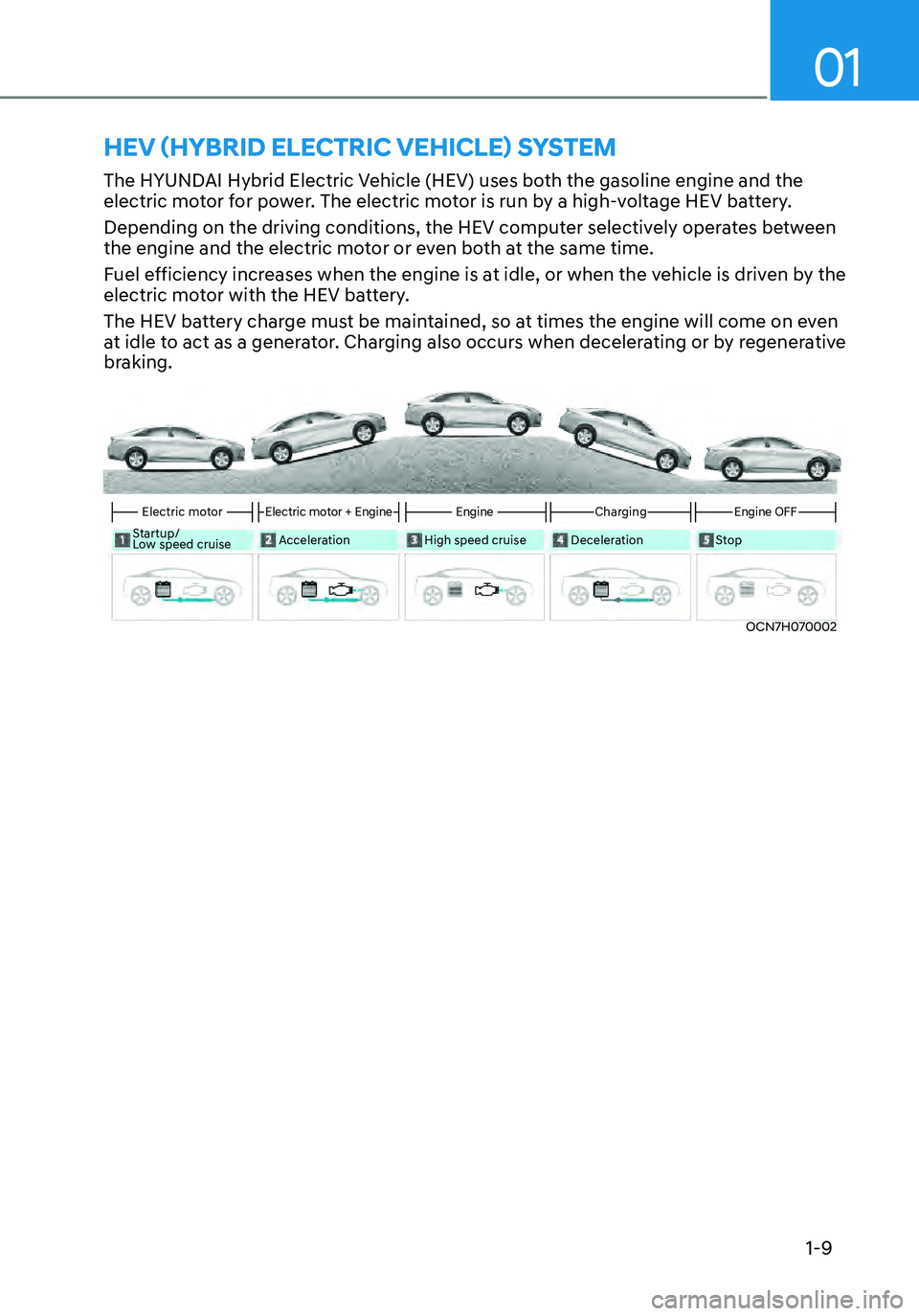
01
1-9
HEV (HYBRID ELECTRIC VEHICLE) SYSTEM
The HYUNDAI Hybrid Electric Vehicle (HEV) uses both the gasoline engine and the
electric motor for power. The electric motor is run by a high-voltage HEV battery.
Depending on the driving conditions, the HEV computer selectively operates between
the engine and the electric motor or even both at the same time.
Fuel efficiency increases when the engine is at idle, or when the vehicle is driven by the
electric motor with the HEV battery.
The HEV battery charge must be maintained, so at times the engine will come on even
at idle to act as a generator. Charging also occurs when decelerating or by regenerative
braking.
OCN7H070002
Startup/
Low speed cruise
Acceleration
High speed cruise Deceleration Stop
Electric motorElectric motor + EngineEngineChargingEngine OFF
Page 15 of 555
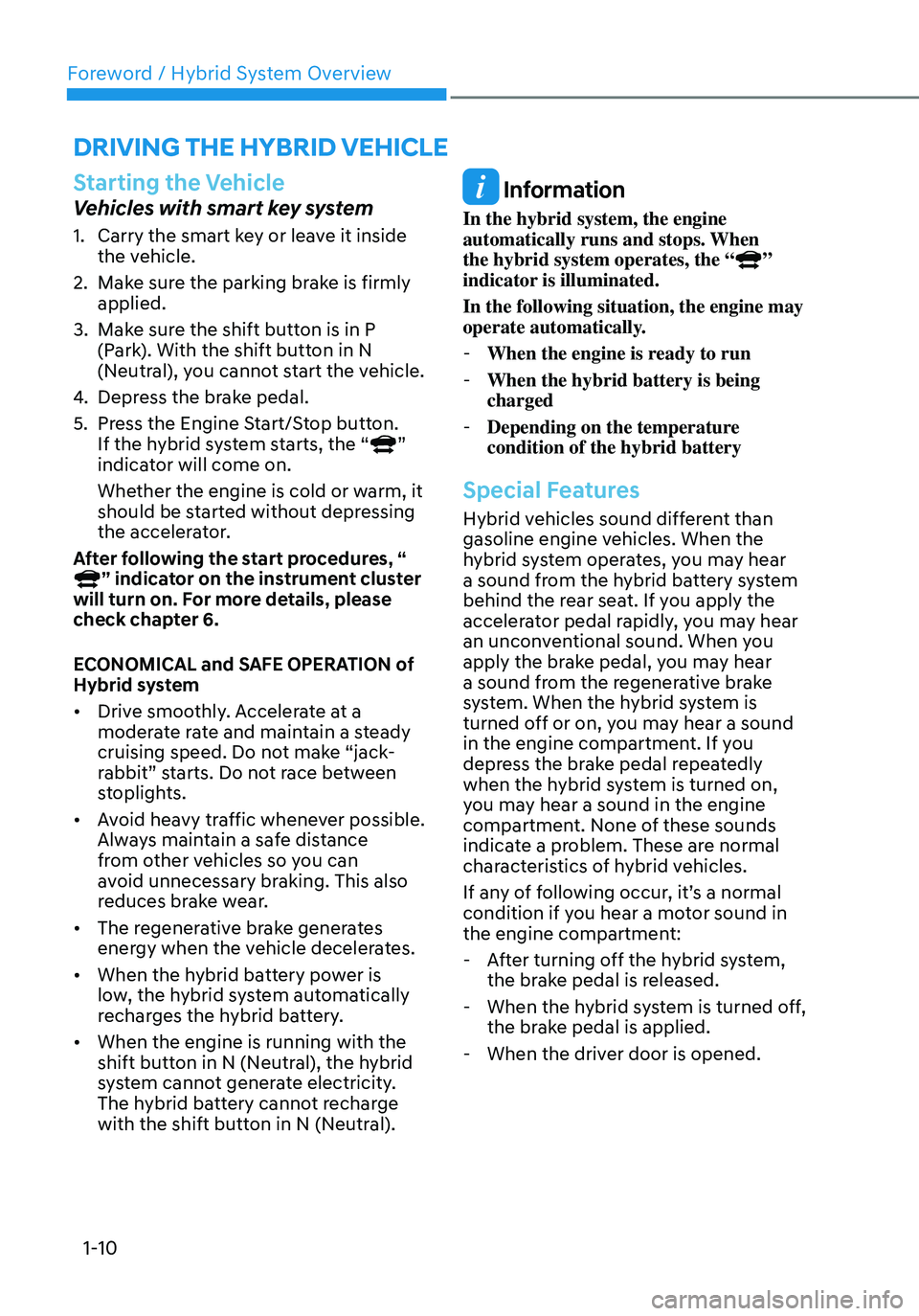
Foreword / Hybrid System Overview
1-10
Starting the Vehicle
Vehicles with smart key system
1. Carry the smart key or leave it inside
the vehicle.
2. Make sure the parking brake is firmly
applied.
3. Make sure the shift button is in P
(Park). With the shift button in N
(Neutral), you cannot start the vehicle.
4. Depress the brake pedal.
5. Press the Engine Start/Stop button.
If the hybrid system starts, the “” indicator will come on.
Whether the engine is cold or warm, it
should be started without depressing
the accelerator.
After following the start procedures, “
” indicator on the instrument cluster will turn on. For more details, please
check chapter 6.
ECONOMICAL and SAFE OPERATION of
Hybrid system
• Drive smoothly. Accelerate at a
moderate rate and maintain a steady
cruising speed. Do not make “jack-
rabbit” starts. Do not race between
stoplights.
• Avoid heavy traffic whenever possible.
Always maintain a safe distance
from other vehicles so you can
avoid unnecessary braking. This also
reduces brake wear.
• The regenerative brake generates
energy when the vehicle decelerates.
• When the hybrid battery power is
low, the hybrid system automatically
recharges the hybrid battery.
• When the engine is running with the
shift button in N (Neutral), the hybrid
system cannot generate electricity.
The hybrid battery cannot recharge
with the shift button in N (Neutral).
Information
In the hybrid system, the engine
automatically runs and stops. When
the hybrid system operates, the “
” indicator is illuminated.
In the following situation, the engine may
operate automatically.
-When the engine is ready to run
-When the hybrid battery is being
charged
-Depending on the temperature
condition of the hybrid battery
Special Features
Hybrid vehicles sound different than
gasoline engine vehicles. When the
hybrid system operates, you may hear
a sound from the hybrid battery system
behind the rear seat. If you apply the
accelerator pedal rapidly, you may hear
an unconventional sound. When you
apply the brake pedal, you may hear
a sound from the regenerative brake
system. When the hybrid system is
turned off or on, you may hear a sound
in the engine compartment. If you
depress the brake pedal repeatedly
when the hybrid system is turned on,
you may hear a sound in the engine
compartment. None of these sounds
indicate a problem. These are normal
characteristics of hybrid vehicles.
If any of following occur, it’s a normal
condition if you hear a motor sound in
the engine compartment:
-After turning off the hybrid system,
the brake pedal is released.
-When the hybrid system is turned off,
the brake pedal is applied.
-When the driver door is opened.
DRIVING THE HYBRID VEHICLE
Page 16 of 555
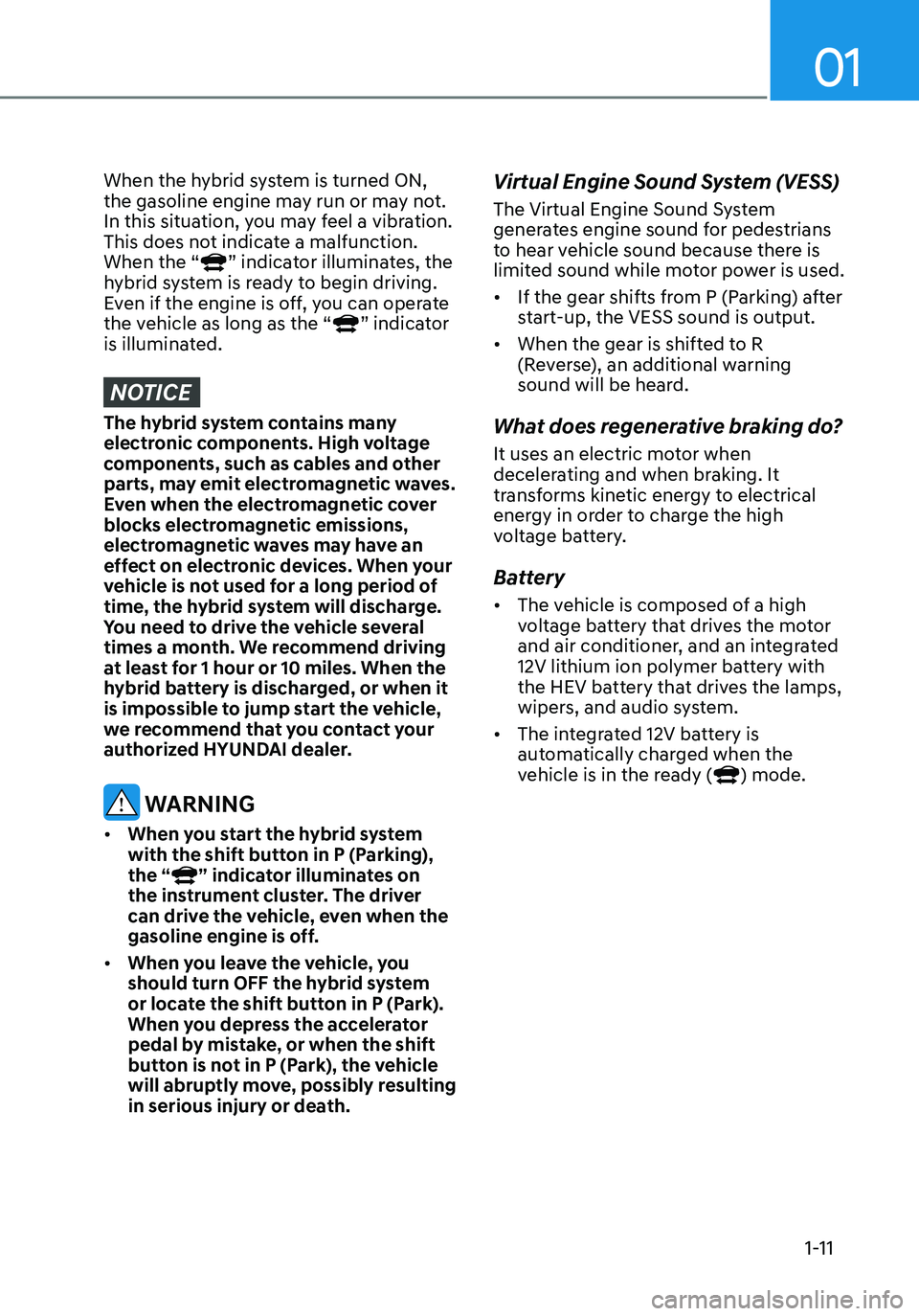
01
1-11
When the hybrid system is turned ON,
the gasoline engine may run or may not.
In this situation, you may feel a vibration.
This does not indicate a malfunction.
When the “
” indicator illuminates, the hybrid system is ready to begin driving.
Even if the engine is off, you can operate
the vehicle as long as the “
” indicator is illuminated.
NOTICE
The hybrid system contains many
electronic components. High voltage
components, such as cables and other
parts, may emit electromagnetic waves.
Even when the electromagnetic cover
blocks electromagnetic emissions,
electromagnetic waves may have an
effect on electronic devices. When your
vehicle is not used for a long period of
time, the hybrid system will discharge.
You need to drive the vehicle several
times a month. We recommend driving
at least for 1 hour or 10 miles. When the
hybrid battery is discharged, or when it
is impossible to jump start the vehicle,
we recommend that you contact your
authorized HYUNDAI dealer.
WARNING
• When you start the hybrid system
with the shift button in P (Parking),
the “
” indicator illuminates on the instrument cluster. The driver
can drive the vehicle, even when the
gasoline engine is off.
• When you leave the vehicle, you
should turn OFF the hybrid system
or locate the shift button in P (Park).
When you depress the accelerator
pedal by mistake, or when the shift
button is not in P (Park), the vehicle
will abruptly move, possibly resulting
in serious injury or death.
Virtual Engine Sound System (VESS)
The Virtual Engine Sound System
generates engine sound for pedestrians
to hear vehicle sound because there is
limited sound while motor power is used.
• If the gear shifts from P (Parking) after
start-up, the VESS sound is output.
• When the gear is shifted to R
(Reverse), an additional warning
sound will be heard.
What does regenerative braking do?
It uses an electric motor when
decelerating and when braking. It
transforms kinetic energy to electrical
energy in order to charge the high
voltage battery.
Battery
• The vehicle is composed of a high
voltage battery that drives the motor
and air conditioner, and an integrated
12V lithium ion polymer battery with
the HEV battery that drives the lamps,
wipers, and audio system.
• The integrated 12V battery is
automatically charged when the
vehicle is in the ready (
) mode.
Page 17 of 555
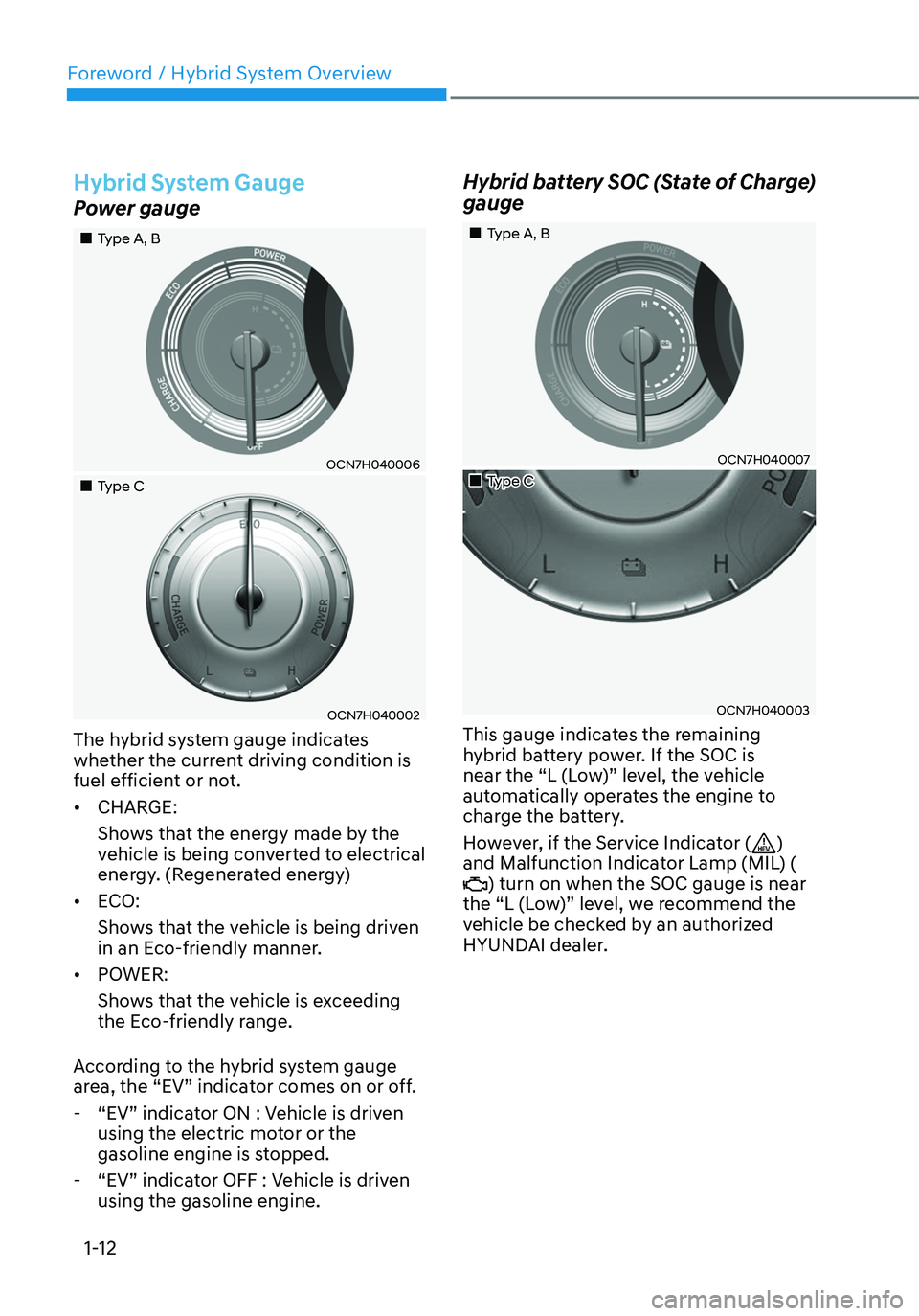
Foreword / Hybrid System Overview
1-12
Hybrid System Gauge
Power gauge
„„Type A, B
OCN7H040006
„„Type C
OCN7H040002
The hybrid system gauge indicates
whether the current driving condition is
fuel efficient or not.
• CHARGE:
Shows that the energy made by the
vehicle is being converted to electrical
energy. (Regenerated energy)
• ECO:
Shows that the vehicle is being driven
in an Eco-friendly manner.
• POWER:
Shows that the vehicle is exceeding
the Eco-friendly range.
According to the hybrid system gauge
area, the “EV” indicator comes on or off.
- “EV” indicator ON : Vehicle is driven
using the electric motor or the
gasoline engine is stopped.
-“EV” indicator OFF : Vehicle is driven
using the gasoline engine.
Hybrid battery SOC (State of Charge)
gauge
„„Type A, B
OCN7H040007
„„Type C
OCN7H040003
This gauge indicates the remaining
hybrid battery power. If the SOC is
near the “L (Low)” level, the vehicle
automatically operates the engine to
charge the battery.
However, if the Service Indicator (
) and Malfunction Indicator Lamp (MIL) () turn on when the SOC gauge is near the “L (Low)” level, we recommend the
vehicle be checked by an authorized
HYUNDAI dealer.
Page 18 of 555
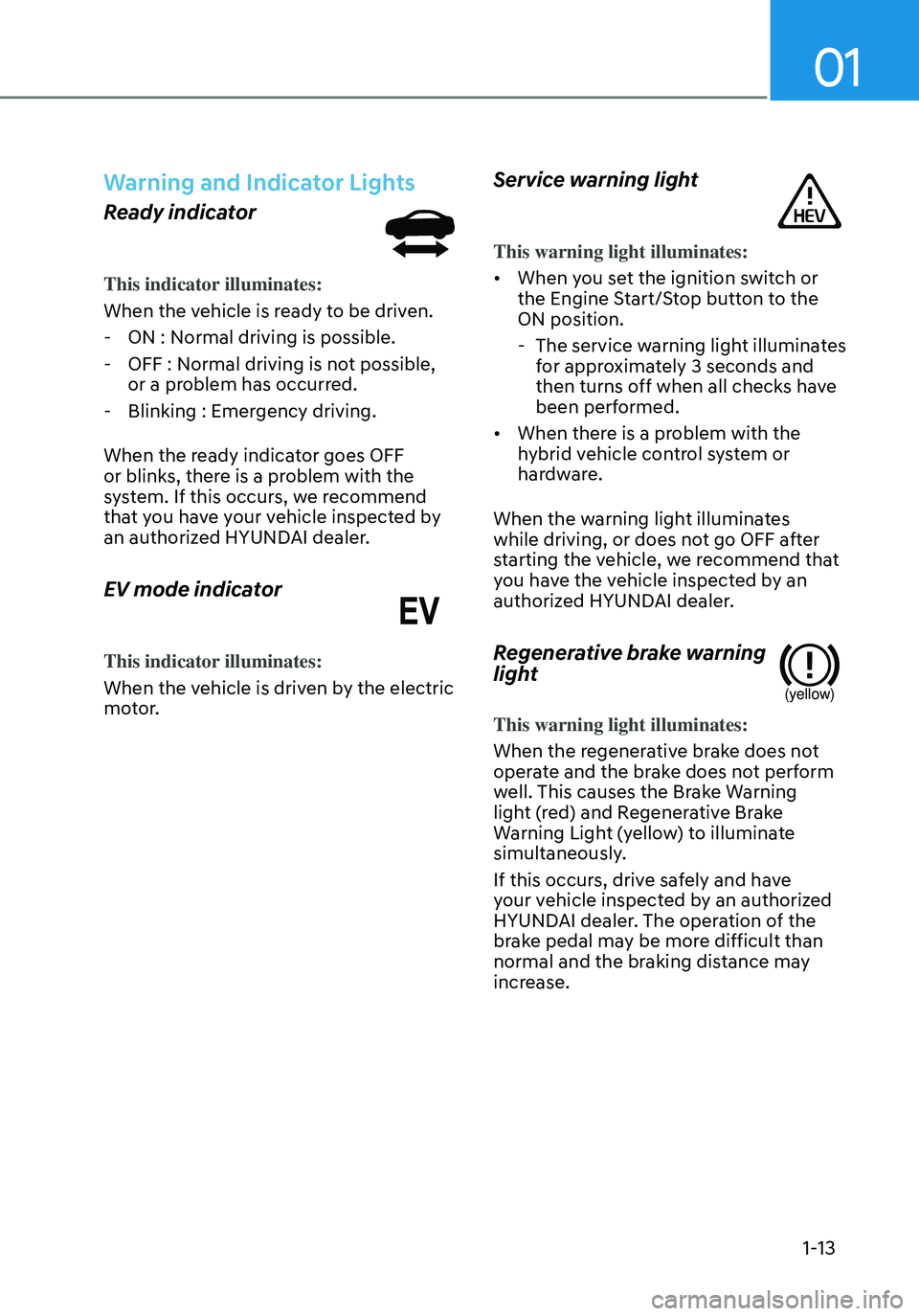
01
1-13
Warning and Indicator Lights
Ready indicator
This indicator illuminates:
When the vehicle is ready to be driven.
-ON : Normal driving is possible.
-OFF : Normal driving is not possible,
or a problem has occurred.
-Blinking : Emergency driving.
When the ready indicator goes OFF
or blinks, there is a problem with the
system. If this occurs, we recommend
that you have your vehicle inspected by
an authorized HYUNDAI dealer.
EV mode indicator
This indicator illuminates:
When the vehicle is driven by the electric
motor.
Service warning light
This warning light illuminates:
• When you set the ignition switch or
the Engine Start/Stop button to the
ON position.
-The service warning light illuminates
for approximately 3 seconds and
then turns off when all checks have
been performed.
• When there is a problem with the
hybrid vehicle control system or
hardware.
When the warning light illuminates
while driving, or does not go OFF after
starting the vehicle, we recommend that
you have the vehicle inspected by an
authorized HYUNDAI dealer.
Regenerative brake warning
light
(yellow)
This warning light illuminates:
When the regenerative brake does not
operate and the brake does not perform
well. This causes the Brake Warning
light (red) and Regenerative Brake
Warning Light (yellow) to illuminate
simultaneously.
If this occurs, drive safely and have
your vehicle inspected by an authorized
HYUNDAI dealer. The operation of the
brake pedal may be more difficult than
normal and the braking distance may
increase.
Page 19 of 555
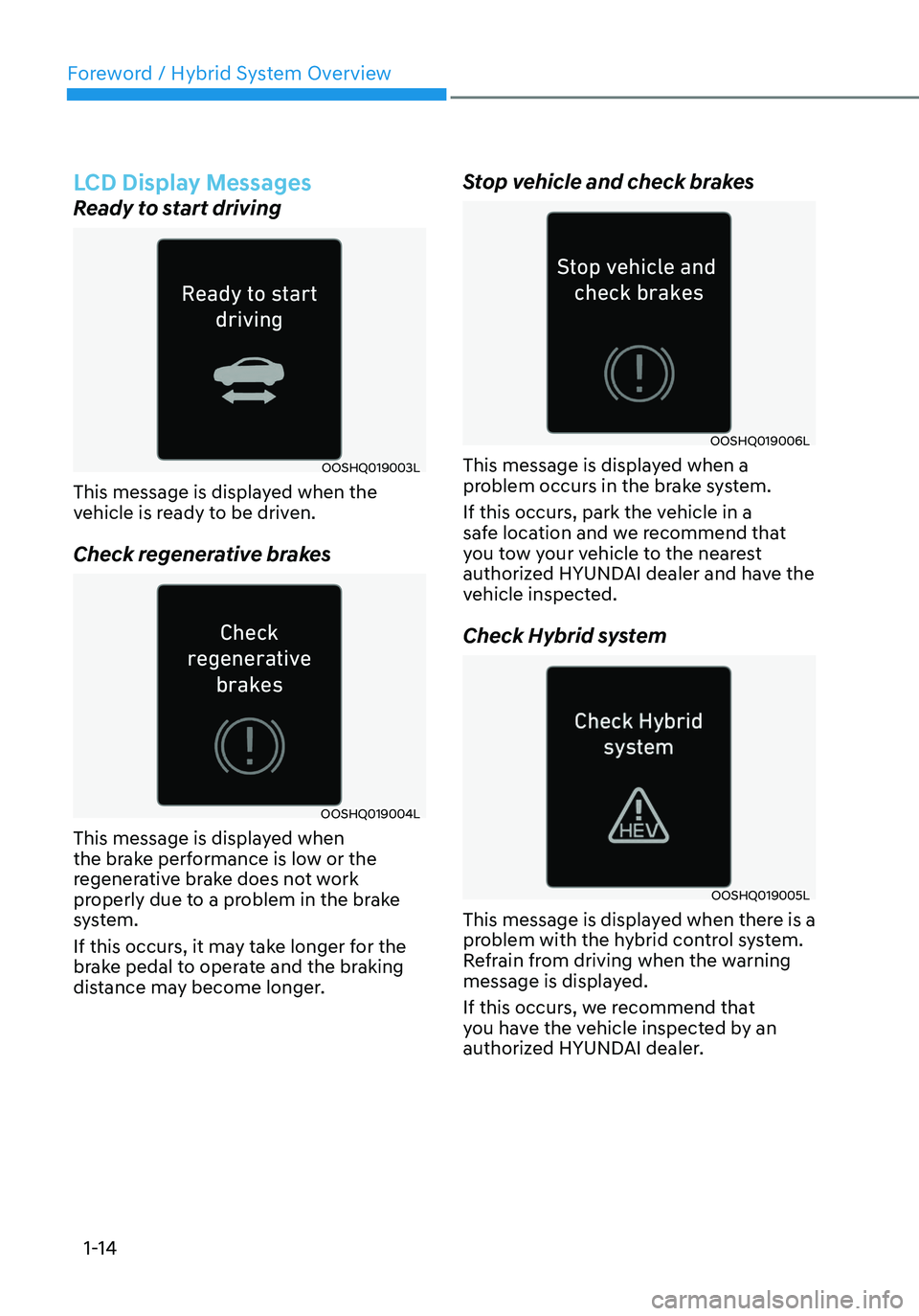
Foreword / Hybrid System Overview
1-14
LCD Display Messages
Ready to start driving
OOSHQ019003L
This message is displayed when the
vehicle is ready to be driven.
Check regenerative brakes
OOSHQ019004L
This message is displayed when
the brake performance is low or the
regenerative brake does not work
properly due to a problem in the brake
system.
If this occurs, it may take longer for the
brake pedal to operate and the braking
distance may become longer.
Stop vehicle and check brakes
OOSHQ019006L
This message is displayed when a
problem occurs in the brake system.
If this occurs, park the vehicle in a
safe location and we recommend that
you tow your vehicle to the nearest
authorized HYUNDAI dealer and have the
vehicle inspected.
Check Hybrid system
OOSHQ019005L
This message is displayed when there is a
problem with the hybrid control system.
Refrain from driving when the warning
message is displayed.
If this occurs, we recommend that
you have the vehicle inspected by an
authorized HYUNDAI dealer.
Page 20 of 555
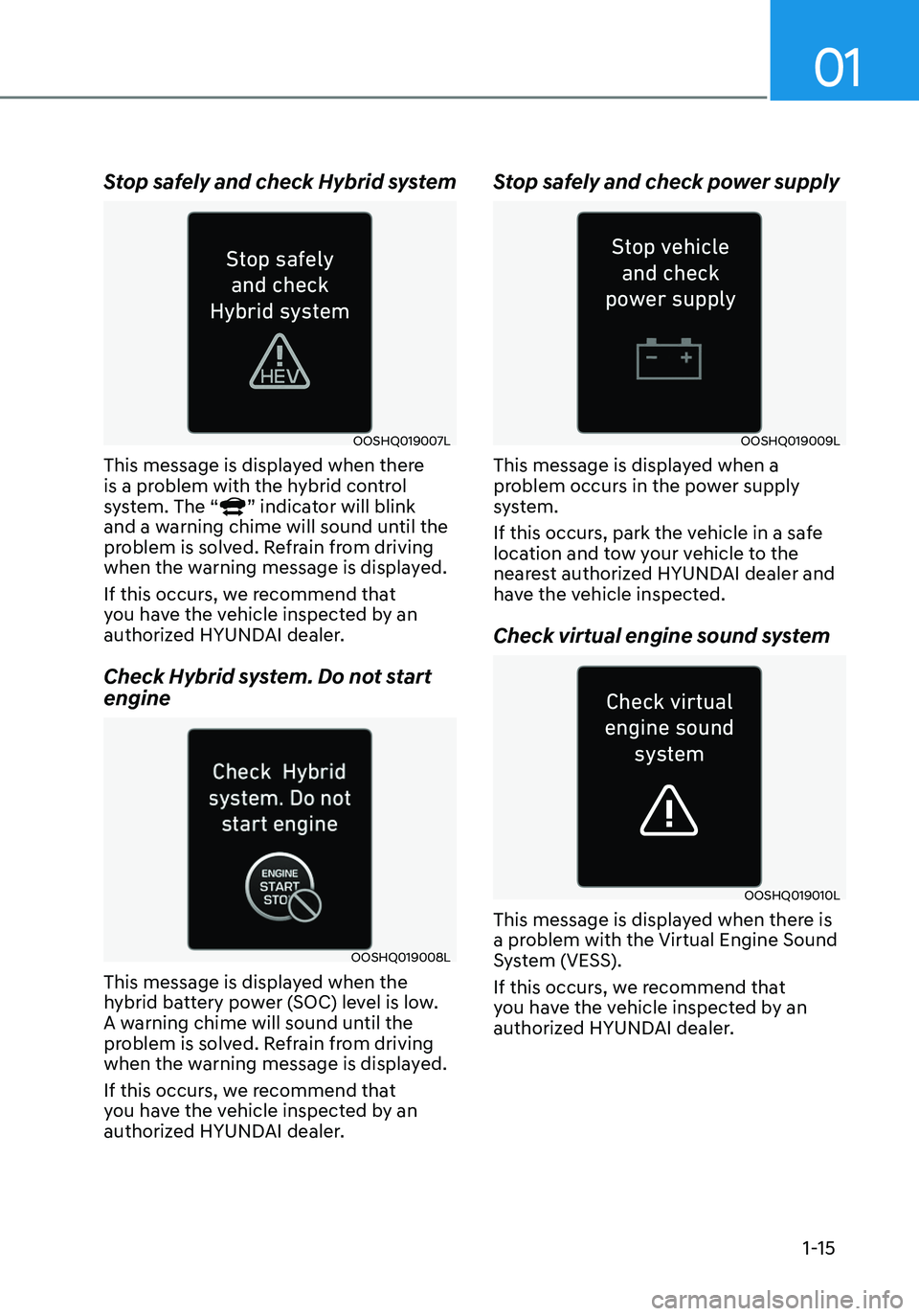
01
1-15
Stop safely and check Hybrid system
OOSHQ019007L
This message is displayed when there
is a problem with the hybrid control
system. The “
” indicator will blink and a warning chime will sound until the
problem is solved. Refrain from driving
when the warning message is displayed.
If this occurs, we recommend that
you have the vehicle inspected by an
authorized HYUNDAI dealer.
Check Hybrid system. Do not start
engine
OOSHQ019008L
This message is displayed when the
hybrid battery power (SOC) level is low.
A warning chime will sound until the
problem is solved. Refrain from driving
when the warning message is displayed.
If this occurs, we recommend that
you have the vehicle inspected by an
authorized HYUNDAI dealer.
Stop safely and check power supply
OOSHQ019009L
This message is displayed when a
problem occurs in the power supply
system.
If this occurs, park the vehicle in a safe
location and tow your vehicle to the
nearest authorized HYUNDAI dealer and
have the vehicle inspected.
Check virtual engine sound system
OOSHQ019010L
This message is displayed when there is
a problem with the Virtual Engine Sound
System (VESS).
If this occurs, we recommend that
you have the vehicle inspected by an
authorized HYUNDAI dealer.